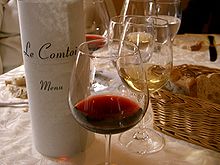
Back نبيذ فرنسي Arabic Vi francès Catalan Vinařské oblasti ve Francii Czech Франци эрехĕсем CV Weinbau in Frankreich German Listo de francaj vinoj Esperanto Vino de Francia Spanish Prantsusmaa veinid Estonian شراب فرانسوی Persian Viinintuotanto Ranskassa Finnish
This article needs additional citations for verification. (September 2023) |



French wine is produced throughout all of France in quantities between 50 and 60 million hectolitres per year, or 7–8 billion bottles. France is one of the largest wine producers in the world.[1][2] French wine traces its history to the 6th century BCE, with many of France's regions dating their wine-making history to Roman times. The wines produced range from expensive wines sold internationally to modest wines usually only seen within France such as the Margnat wines of the post-war period.
Two concepts central to the better French wines are the notion of terroir, which links the style of the wines to the locations where the grapes are grown and the wine is made, and the Protected designation of origin (Appellation d'Origine Protégée, AOP) system, named Appellation d'origine contrôlée (AOC) ubtil 2012. Appellation rules closely define which grape varieties and winemaking practices are approved for classification in each of France's several hundred geographically defined appellations, which can cover regions, villages or vineyards. France is the source of many grape varieties (such as Cabernet Sauvignon, Chardonnay, Pinot noir, Sauvignon blanc, Syrah) that are now planted throughout the world, as well as wine-making practices and styles of wine that have been adopted in other producing countries. Although some producers have benefited in recent years from rising prices and increased demand for prestige wines from Burgundy and Bordeaux, competition from New World wines has contributed to a decline in the domestic and international consumption of French wine on to 40 liters per capita.[3][1]
- ^ a b Green, Martin (15 November 2024). "France will uproot 27,500 hectares of vineyards to combat oversupply crisis" (PDF). Decanter. Retrieved 16 November 2024.
- ^ "World wine production reaches record level in 2018, consumption is stable". BKWine Magazine. 14 April 2019. Retrieved 18 November 2019.
- ^ Henley, Jon. "French attempt to arrest drastic fall in wine sales". the Guardian. Retrieved 1 July 2022.